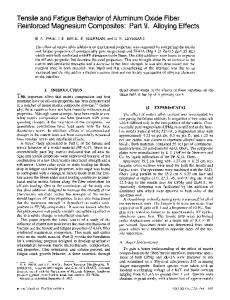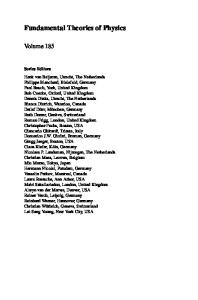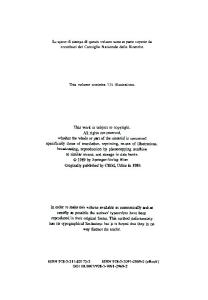Tensile properties of short fiber-reinforced SiC/Al composites: Part II. Finite-element analysis
- PDF / 1,162,486 Bytes
- 10 Pages / 594 x 774 pts Page_size
- 41 Downloads / 357 Views
I.
INTRODUCTION
IN Part I of this
work, I1] the tensile behavior of a series of aluminum matrix composites reinforced with particulate or whisker SiC was experimentally characterized. The aluminum-matrix alloys were chosen to be a solutionhardened A1-Mg alloy (5456) and a precipitation-hardened A1-Cu-Mg alloy (2124). It was observed that additions of SiC increased the elastic modulus, yield strength, and ultimate tensile strength, and that current theories were not able to predict these effects accurately. It was also found that small (8 pct) additions of SiC whiskers or particulate decreased the proportional limit and that larger amounts of SiC (20 pct) restored this decrease. Previous workers have proposed that the tensile behavior of these materials can be understood either on the basis of shear lag theory I2] or, alternatively, by considering modifications to the initial dislocation microstructure r31 and including the effects of processing-induced residual stress, r4j General agreement on the correct interpretation of the results has not yet been attained, t5'6~ and neither theory seems capable of completely explaining the observations described in Part I. tl] Additional work has indicated that for SiC/AI and AI203/A1 composites, portions of each of the viewpoints appear to be c o r r e c t . [7'8] In attempts to understand the behavior of short fiber-reinforced composites, Eshelby-type models, in which the whiskers are represented as ellipsoidal inclusions, have been used to investigate discontinuously reinforced composites. I9-121 However, these models are restricted to consideration of plastic behavior in a very approximate manner. In view of the need for a detailed description of elastoplastic behavior in which the history of plastic deformation is accounted for, it was thought worthwhile to approach the A. LEVY, Senior Staff Scientist, and J.M. PAPAZIAN, Principal Staff Scientist, are with the Corporate Research Center, Grumman Corporation, Bethpage, NY 11714-3580. Manuscript submitted June 22, 1989. METALLURGICAL TRANSACTIONS A
problem from another perspective. The perspective adopted in this work, therefore, focuses on the use of elastoplastic finite-element analysis of the tensile deformation of these composites.
II.
APPROACH
A. General The approach adopted involved the construction of two finite-element models. In both models, the actual microstructures are simplified by assuming that the fibers can be represented as longitudinally aligned, unidirectional cylinders in a periodic three-dimensional array. The fiber ends are transversely aligned in one model and staggered in the other. The goal was to predict the overall stressstrain behavior for composite materials using the properties of the matrix and the fibers as the starting point. Once the general behavior of the models was verified and their predictions compared with existing experimental results to establish a level of confidence in their validity, they were used to investigate the sensitivity of composite behavior to microstructural vari
Data Loading...











